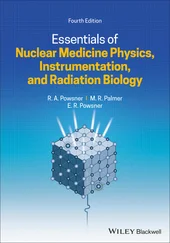Variation in the internal conversion coefficient,
α Kwith atomic nu...Figure 2.18.
Variation in internal conversion coefficients ( α K) eland (
α K) magre...Figure 2.19. General diagram of nuclear deexcitation by delayed-neutron emission...Figure 2.20. Bound levels and virtual levels of the nitrogen-14 nucleus. All lev...Figure 2.21. Diagram of nuclear deexcitation by delayed-neutron emission by the ...Figure 2.22. Summary of the treatment of binding energy within the framework of ...Figure 2.23.
Mass parabola for the isobars of odd A Figure 2.24. Mass parabola for the isobars of even A. Note that there are two pa...Figure 2.25. Profile of the nuclear potential barrier between a nucleus of charg...Figure 2.26. Modified profile of the nuclear potential barrier between a nucleus...Figure 2.27.
Nuclear levels of platinum-188 and thorium-228. For clarity, the en...Figure 2.28.
γ -transitions to the ground level of the neon-22 nucleus Figure 2.29. Curve indicating the variation in the Napierian logarithm of the ra...Figure 2.30a. Shell structure derived from a harmonic potential (a) and distribu...Figure 2.30b. Shell structure derived from a harmonic potential (a) and distribu...Figure 2.30c. Shell structure derived from a harmonic potential (a) and distribu...Figure 2.31.
Charge Q (r) contained in the nuclear envelope with radius r Figure 2.32. Internal and external electric fields created by charges Q (r) and ...
3 Chapter 3Figure 3.1. Creation of electron-positron pair by a process of materialization o...Figure 3.2. Process of annihilation of an electron-positron pair with production...Figure 3.3. Neutron decay by low interaction. It is the decay of the W −boson in...Figure 3.4. Proton decay by low interaction. It is the decay of the W+ boson int...Figure 3.5. Cowan and Reines experimental set-up Figure 3.6. Separation, by a uniform electric field, of α , β and γ radiations em...Figure 3.7. Exponential decay of the number, N(t), of radioactive nuclei Figure 3.8. α decay energy diagram Figure 3.9. Uranium-232 α decay energy diagram Figure 3.10. Variation of curve for several α ZX emitters (polonium 84Po, prota...Figure 3.11. Modeling of α emission by tunnel effect. The barrier width is equal...Figure 3.12. Curve of variation as a function of time of the opposite of the Nap...Figure 3.13. Uranium-233 α decay energy diagram
4 Chapter 4Figure 4.1a. Experimental set-up of Frédéric and Irène Joliot-Curie that led to ...Figure 4.1b. Experimental set-up of Frédéric and Irène Joliot-Curie that led to ...Figure 4.2a. Description of a Geiger-Müller counter Figure 4.2b. Measuring principle using a Geiger-Müller counter. Source: https://...Figure 4.3. β − emission spectrum of phosphorus-32 Figure 4.4. β +emission spectrum of phosphorus-30Figure 4.5. Sargent diagram in its original form according to [SAR 33] Figure 4.6. β −decay energy diagram of cesium-137 (T = 32 years). The diagram sh...Figure 4.7. β +decay energy diagram of sodium-22 (T = 2.58 years). The diagram s...Figure 4.8. Decay energy diagram of sodium-22 by electron capture (EC) and by β +...Figure 4.9. α and β − decay modes of radon-221 Figure 4.10. Process of atomic deexcitation by emission of X-rays or of an Auger...Figure 4.11. Relative arrangement of the K-, L- and M-shells of copper atoms Figure 4.12. Electron-hole recombination processes Figure 4.13. Evolution curves of the activities of tellurium-131 and its daughte...Figure 4.14. Variation in the activity, A2 (t), of a radionuclide, X2, obtained ...Figure 4.15. Natural series of thorium. The stable end product of the family tre...Figure 4.16. Artificial series of neptunium. The stable end product of the famil...Figure 4.17. Natural series of uranium-235. The stable end product of the family...Figure 4.18. Natural series of uranium-238 (often called uranium-radium series)....Figure 4.19. Decay energy diagram of vanadium-48 Figure 4.20. Energy spectra of β particles emitted by copper-64 Figure 4.21. β decay energy diagram of indium-114 Figure 4.22. Distribution of nucleons of titanium-48: (a) shell structure derive...Figure 4.23. Distribution of nucleons of vanadium-48: (a) shell structure derive...Figure 4.24. The most probable electric quadrupole transitions (E2) between exci...Figure 4.25. Decay energy diagram of vanadium-74 Figure 4.26. Maximum energy of β− and β+ spectra of copper-64 Figure 4.27. Decay energy diagram of potassium-48. Of particular note are its th...
1 Chapter 1 Table 1.1. Fundamental properties of nucleons Table 1.2. Molar percentages of the most significant isotopes of the first ten e...Table 1.3. Electron and nucleon masses in u and MeV/c2
2 Chapter 2Table 2.1. Order of the quantum states of a nucleon within the framework of the ...Table 2.2. Properties of a nucleon subjected to a harmonic potential Table 2.3. Classification of the γ -transitions according to the multipole order Table 2.4. Values of the Cℓ(E) and Cℓ(E) coefficients for γ -transitions Table 2.5. Number of stable nuclei with respect to the parity of Z and N Table 2.6. Calculating the average value of the ratio aa/ac Table 2.7. Binding energy and atomic mass of some nuclides. The calculated value...Table 2.8. Families of coefficients av, as, aa, ac, and ap Table 2.9. Values of Zmin calculated from the values of ac and aa gathered in Ta...Table 2.10. Decay number 〈 N 〉 measured during a constant duration of 5s Table 2.11. Comparison of the experimental (Bexp) and theoretical (Btheo) values...Table 2.12. Theoretical values of the Coulomb coefficient and of the difference ...Table 2.13. Comparison of the experimental [MAR 69] and theoretical values of th...Table 2.14. Comparison of the experimental [MAR 69] and theoretical values of th...Table 2.15. Values of the ratio A0/A(t) of the initial and instantaneous activit...Table 2.16. Comparison of the experimental (Bexp) and theoretical (Btheo) values...Table 2.17. Theoretical values of the Coulomb coefficient and of the difference ...Table 2.18. Comparison of the experimental [MAR 69] and theoretical values of th...Table 2.19. Comparison of the experimental [MAR 69] and theoretical values of th...
3 Chapter 3Table 3.1. Radioactive half-life of several radionuclides Table 3.2. Energies of the γ photons and α particles emitted during the decay of...Table 3.3. Correlation between the radioactive half-life, T, and kinetic energy,...Table 3.4. Variation as a function of time in the ratio of the number, N(t), of ...Table 3.5. Atomic masses of several nuclides Table 3.6. Variation as a function of time of the opposite of the Napierian loga...
4 Chapter 4Table 4.1. Several (β,γ) emitters. The (β +,γ) emitters are all artificial Table 4.2. Correspondence between the Siegbahn notation and that of the IUPAC in...Table 4.3. Classification of energy levels and X-rays in Siegbahn notation Table 4.4. Correspondence between old and conventional nucleus notations. The ra...Table 4.5. Correspondence between old and conventional nucleus notations. The ra...Table 4.6. Correspondence between old and conventional nucleus notations. The ra...Table 4.7. Experimental values of maximum energy Emax of the β +spectra of sever...Table 4.8. Comparison of the experimental values of maximum energy, Emax, of the ...
Читать дальше











